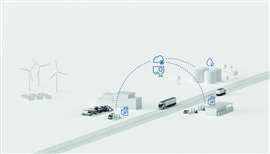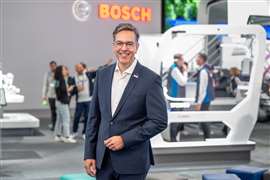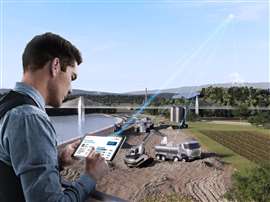Bauma Interview: Jan-Oliver Roehrl on Bosch’s Digital Fuel Twin
06 May 2025
Julian Buckley spoke with Bosch’s Jan-Oliver Roehrl at the recent Bauma trade fair in Munich about the company’s new Digital Fuel Twin initiative
 Diagram showing coverage of Digital Fuel Twin solution (Photo: Bosch)
Diagram showing coverage of Digital Fuel Twin solution (Photo: Bosch)
As a drop-in replacement for fossil diesel, HVO (hydrotreated vegetable oil, also known as renewable diesel in North America) offers a series of benefits, not least a considerable reduction in overall carbon emissions due to the carbon dioxide originally absorbed by the reclaimed biomass used as feedstock for the fuel.
As a leading technology developer and component supplier active in virtually all vehicle sectors, including on-highway trucks and off-highway machines, Bosch is forecasting that four out of every five construction vehicles operating around the world with an output greater than 56 kW will still be powered by an internal combustion engine by 2035.
This, the German Tier supplier puts forward, is why it will continue to develop next-gen fuel injection technologies and urea emissions systems, with the goal of continuing to reduce engine emissions from these machines.
But while such endeavours will certainly result in improved solutions, HVO fuel already offers a nearly carbon-neutral alternative for off-highway machines. The downside to this is that the use of HVO is currently only unofficially reported, making it impossible to accurately quantify the specific CO2 emissions reduction benefits.
Digital Fuel Twin
With the goal of achieving greater transparency in the use of and CO2 reductions related to HVO, Bosch has proposed its Digital Fuel Twin solution. The wholly digital software system would extend from the fuel refinery through to the distributor and ultimately the filling station, recording the volumes of produced/distributed fuel together with the product’s sustainability credentials.
In addition to this, it would provide machine operators with certificates showing what fuel they had used, even documenting the total amount of fuel and the proportional reduction in carbon emissions over using fossil diesel.
“The Digital Fuel Twin provides evidence to the fuel user about what type of product they have just pumped into their vehicle,” says Jan-Oliver Roehrl, executive vice president of the Bosch Power Solutions Division and chairman of the Commercial Vehicles activities at Bosch, who spoke with Power Progress International at the recent Bauma construction machine trade fair in Munich.
“On top of that, it shows to what degree the fuel is CO2-neutral, which highlights the energy type used to generate the HVO product,” he added.
The cloud-based solution effectively delivers a well-to-wheel passport for the fuel used, which could then be used to both identify the achieved benefits and certifying that HVO had been used by the operator.
The type of energy being used to produce the HVO would have to be released by the refinery. But Roehrl says the target of the exercise is to provide evidence of the product’s sustainability credentials, not to take issue with methods used by a given refinery.
 (Photo: Bosch)
(Photo: Bosch)
“The Digital Fuel Twin provides evidence to the fuel user about what type of product they have just pumped into their vehicle” Jan-Oliver Roehrl, Bosch
“The solution would work for both on- and off-highway,” he explains. “But it would be very significant for off-highway. Many inner city construction sites demand an emissions certificate and this would be a traceable, verifiable source of that information.”
As the HVO fuel moves through the system, the volumes produced and distributed will also have to match, effectively proving that what has been produced has been distributed – and making it virtually impossible to claim more HVO has been taken out of the distribution network than was put in.
“This is key for the fleet operator. The information will be stored in the system, but it can also be used as part of the fleet operator’s sustainability report,” states Roehrl.
Support agreements
Key to achieving the goal of the Digital Fuel Twin is to have the cross-industry support of each entity involved in the production and delivery of HVO. To generate support for getting involved in the project, Bosch is currently running an information campaign to highlight the system benefits.
“We just started this campaign a couple of weeks ago. We have a series of vehicles on a tour of Europe using HVO where possible and they will finish this route in Brussels. When that is complete, we will deliver the results to the parliament,” explains Roehrl.
The routes are random in order to measure the availability of renewable fuel and the results will be compared with emissions data across the same routes if the vehicles had used only fossil diesel. A series of fuel companies are backing the info campaign, including Neste, Repsol and Eni, while vehicles are provided by BMW, Volkswagen, Hyundai, Honda, Daimler Truck and DAF. Bosch has equipped all the vehicles with the Digital Fuel Twin software to collect data covering fuel quality and related sustainability.
 Digital Fuel Twin is a cloud-based software which documents the use ot renewable fuel (Photo: Bosch)
Digital Fuel Twin is a cloud-based software which documents the use ot renewable fuel (Photo: Bosch)
Roehrl: “We want to show the renewable fuels are available in sufficient quantities to support sustainable transport. What’s important is that we don’t see this as competition for electrification. We want the Digital Fuel Twin to support an alternative to electrification.”
Looking at construction machines, the Digital Fuel Twin is currently a retrofit system. With no hardware to install onboard, it is hoped that OEMs will embed the related code in their existing vehicle software architectures and make the system standard across future machines.
“EU regulations should offer a benefit to those vehicles and machines which are using HVO,” says Roehrl. “All technologies which support improved sustainability should receive governmental support, at least in the short to mid term.”
POWER SOURCING GUIDE
The trusted reference and buyer’s guide for 83 years
The original “desktop search engine,” guiding nearly 10,000 users in more than 90 countries it is the primary reference for specifications and details on all the components that go into engine systems.
Visit Now
STAY CONNECTED




Receive the information you need when you need it through our world-leading magazines, newsletters and daily briefings.
CONNECT WITH THE TEAM









